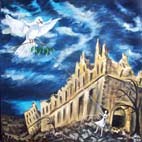This isn't Italy as the tourist brochures show it.
Day two of Quattro Passi Sulla Gustav 2010:
The programme: DOMENICA 18 APRILE 2010
· 8,30 appuntamento al parcheggio multipiano ingresso Via Montecassino,
· 9,00 partenza per Villa Santa Lucia con piccoli autobus riservati, sosta in località “la
cicogna”,
· 9.30 partenza a piedi per Monte Castellone, visita a quota 702, Colle S. Angelo, Cresta del
Fantasma, quota 575 (I luoghi dell’attacco del II Corpo Polacco e la tana del 4°
“Hochgebirsjager”),
· 13.00 pranzo al sacco presso la Fattoria Albaneta,
· 14,30 partenza per quota 593 “Il Calvario” attraverso il sentiero dalla “Cavendish Road”,
· 17,30 fine manifestazione al Cimitero Polacco, in autobus riservato fino al parcheggio
multipiano.
We were a group of about 40 people, with several children of school age amongst us. The day turned out to be a much greater adventure than anyone could have predicted.

It is not uncommon to find bombs in these hills. Mostly, they are not live. Often, however, they are. And, after 66 years out in all weather, they are unstable. That's when it is good to have sharp eyes and follow the beaten path.
Quite often someone has carefully lifted the mortar onto a flat rock in the open so that there is no risk of it being trodden on accidentally.

One hopes that they are then disposed of by an expert, but...
This (below) was the first or second we saw.

This day we had plenty to worry about. Apparently these (below) might contain phosporous.

We took turns at being "on guard" until all were safely out of harm's way.

(Above) Roberto Molle, President of the Association and main organiser of the weekend, made sure that parents and children were aware of the unexpected dangers.
Some were, apparently, more volatile than others. This one (below) had the group organizer firmly planted until all had gone by; there would be no mistakes with this highly unstable American beauty.

The bomb is at the central lower edge of the photo below. It would be easy to assume that it was a piece of rusty pipe, and treat it with scant regard.

Soon I was losing count, and certainly keeping my eyes to the ground.

Not even our regular metal detector weekend trampers were prepared for this one!
(Partially obscured between the trees, at a distance, photo below). It is the biggest anyone in the group had ever seen lying unexploded on the slopes around Cassino. I make no apology for the poor photograph; I wasn't going any closer, nor was I risking losing my balance, possibly sending rocks crashing down onto more nasty surprises, to use two hands to hold the camera and zoom in. I sent the photo to the friend who was leading us down this steep rocky slope and he replied: Dovrebbe trattarsi di un proiettile di artiglieria 205 mm americano (205 mm shell).

The descent was steep, with rocks crashing if people chose the wrong footing. My chosen path, grasping the trees and sticking to the rock face where fewer loose rocks were dislodged, was not the exact path taken by the leaders. It was raining, and slippery, and the first tracks were now too dangerous.

I forged a new and less slippery track and was extremely cautious as I poked my walking stick tip in between the leaves and rocks.
It was strange, though, to realise that I felt no fear, only caution. I'm not sure if that is a good thing or a bad thing!
Members of the group who live near this dangerous slope have contacted authorities, but it is highly likely that these hillsides will continue to be unsafe for a long long time.
 Some of the artists involved in this exhibition have taken the opportunity to produce work different from their usual art. Artist Susan Edge, better known for her colourful, rather whimsical and always cheerful naive art, has used a recent photo of the statue of St Benedict and an ancient painting of St Benedict as her source (below) to produce a work (above) that is both old and new.
Some of the artists involved in this exhibition have taken the opportunity to produce work different from their usual art. Artist Susan Edge, better known for her colourful, rather whimsical and always cheerful naive art, has used a recent photo of the statue of St Benedict and an ancient painting of St Benedict as her source (below) to produce a work (above) that is both old and new. 































.jpg)











